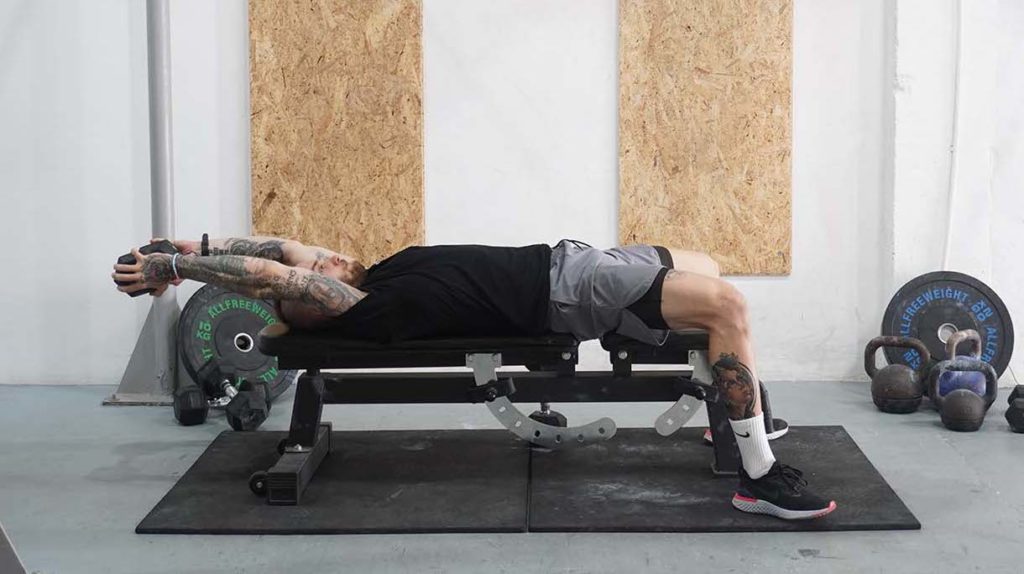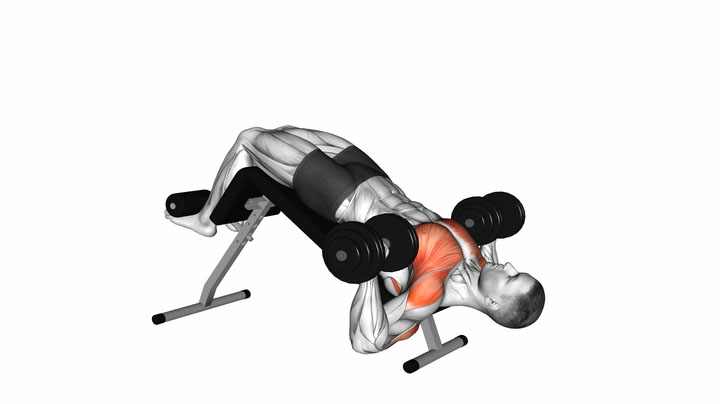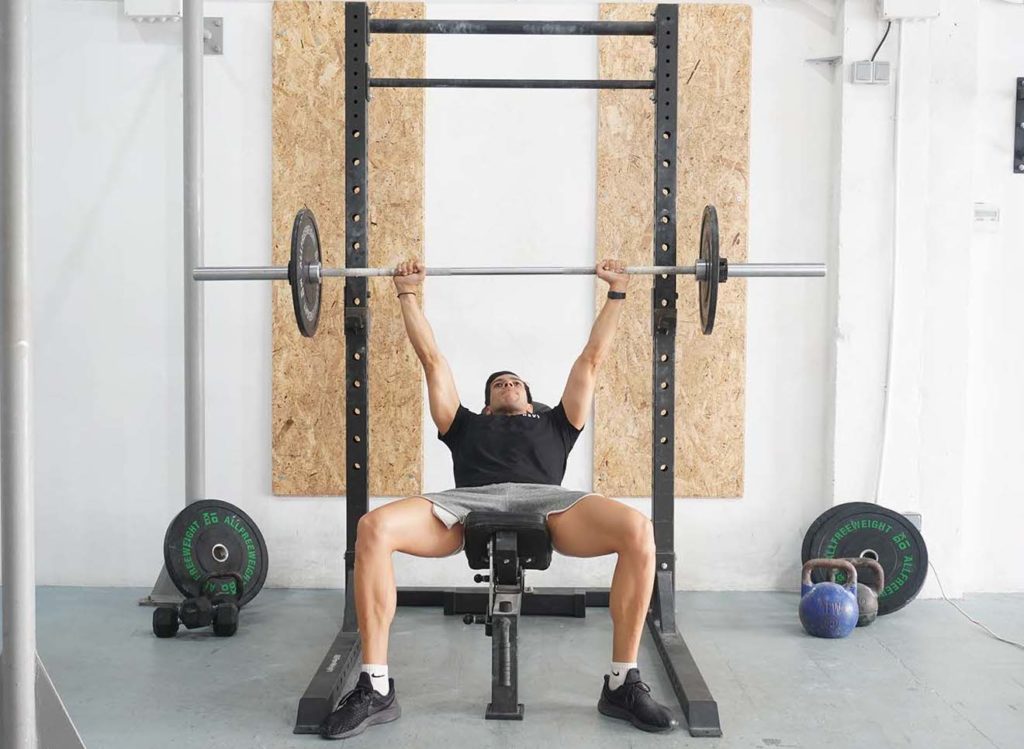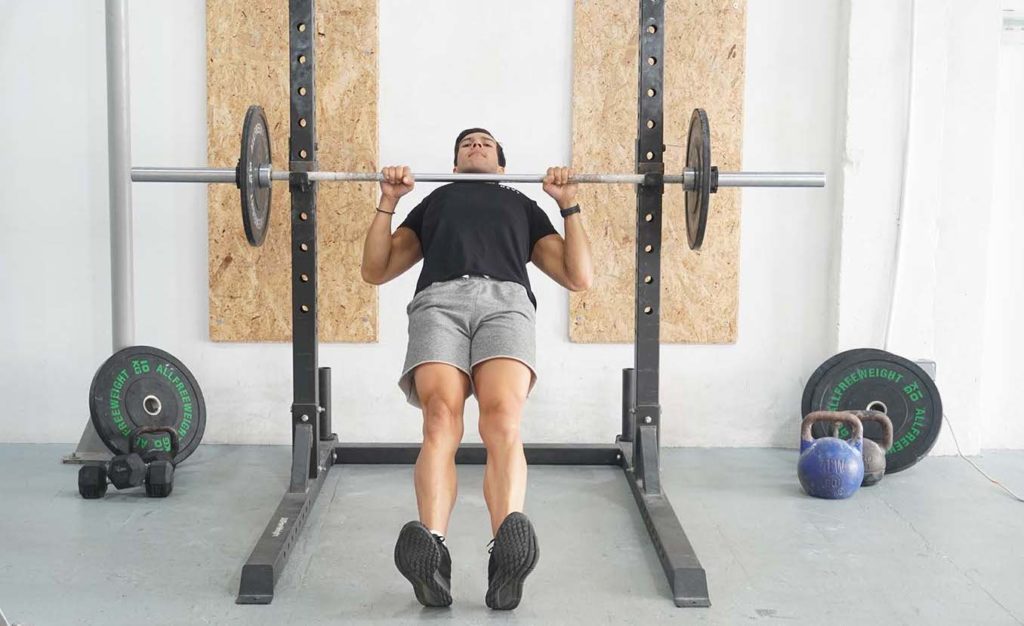How Dumbbell Pullovers Improve Chest Development
Dumbbell pullovers are an effective but overlooked exercise for chest and lat development, core strength, full-body stability, and shoulder stability. The dumbbell pullover develops your chest through shoulder extension, unlike pressing movements where you push weights away from yourself.
The objective during a dumbbell pullover is to get in the starting position by lying on a flat bench, supporting weight in both hands, and extending your elbows. From there, bring your upper arms to the sides of your head and the dumbbell behind your head, stretching your lats and chest. Then, use the same muscles to bring your hands over your torso. The dumbbell pullover works great because it trains your upper body through a good range of motion and offers a fantastic overloading potential for growth.
The dumbbell pullover is also beneficial for your daily life. Dumbbell pullovers develop three large muscles in the upper body (the chest, lats, and deltoids) and increase core stability. As a result, you become more athletic, and tasks that involve your arms become more accessible.
We recommend including the dumbbell pullover near the middle of your training. Pick a moderately-heavy dumbbell and aim for at least 8 to 10 reps per set.
Level of the dumbbell pullover exercise: Intermediate
How to do the Dumbbell Pullover Exercise
- Grab a light weight, sit on a flat bench, and support the dumbbell on one thigh.
- Place both hands over the dumbbell and lift it to chest level.
- Lie back carefully and extend your elbows to position the dumbbell over your chest.
- Place your hands flat against the top weight plate with your palms facing the ceiling and the dumbbell vertical. Keep a slight bend in your elbows.
- Bring your shoulder blades back, have your feet flat on the floor, and squeeze your buttocks to complete the starting position.
- Take a breath and slowly lower the dumbbell back behind your head without bending your elbows.
- Go down as much as your mobility allows to increase the range of motion, hold for a moment, and bring your arms to the starting position. Exhale near the top.
- Take another breath and lower the dumbbell through the same range of motion.
What muscles does the dumbbell pullover activate?
The primary muscle that works during a dumbbell pullover is the chest (pectoralis major). Our pecs control the dumbbell as we bring it back, but their primary job is to assist with shoulder flexion, which occurs as we bring our arms over the torso (1).
Our lat muscles are also involved in the dumbbell pullover. The muscle is the largest in the upper body and covers a significant percentage of the upper and middle back. Our lats are most active as we bring the dumbbell back and assist the pectoral muscles with shoulder flexion. Other back muscles, including the rhomboids, trapezius, and infraspinatus, assist the primary muscles during a dumbbell pullover.
The third of the muscles worked in dumbbell pullovers is the triceps, and the effect is possible because of two things. First, the long head of the triceps originates from the scapula and crosses the shoulder joint, making the muscle contribute to shoulder flexion and stability (2). Second, we have to keep our elbows slightly bent during a dumbbell pullover, leading to constant tension on the triceps.
Our serratus anterior also plays a significant role in dumbbell pullovers. The covers the upper, outer part of the ribcage and assists with scapular protraction during the pullover movement pattern (3).
Proper Form with Preforming the Dumbbell Pullover Exercise
It’s important to note that the dumbbell pullover might not suit everyone. Folks with shoulder pain and excessive upper body tightness should open up their shoulders and thoracic region before attempting the dumbbell pullover. You should be able to extend your arms above your head without arching your lower back excessively because that can put stress on your spine.

The first tip to an effective dumbbell pullover is to keep your elbows in by having your hands slightly apart from one another. Doing so is important for emphasizing the pectoralis major over other muscle groups. In contrast, you should flare your elbows to emphasize the latissimus dorsi during a pullover exercise.
The second tip you should follow is to keep your elbows slightly bent and avoid moving them during the exercise. Doing so is vital for making the exercise chest and lat-focused instead of having your triceps do most of the work. Establishing a good mind-muscle connection can also help you build muscle in the right areas.
You should also maintain midsection tightness during the dumbbell pullover. Aside from helping you generate force more effectively, doing so will prevent excessive back arching and spine stress at the bottom position. Engage your abs before each repetition and keep a slight arch as you start moving the dumbbell back.
Dumbbell Pullover Variations and Modifications
1. Lat-Focused Dumbbell Pullover
The lat-focused dumbbell pullover is identical to the one we reviewed, apart from two differences. First, you should flare your elbows more instead of keeping them close to your head. Second, you must keep your lower back and buttocks in the air, only supporting your upper back on the gym bench. Doing the dumbbell pullover that way is beneficial for increasing the range of motion slightly, placing a more significant stretch on the lats, and training your core muscles.
2. Single-Arm Dumbbell Pullover
The single-arm dumbbell pullover is a neat variation you can do to improve muscle activation, lengthen the range of motion, and reinforce proper technique. Though, doing it with one arm at a time might make it challenging to engage your chest. You can also perform an incline dumbbell pullover if you find that it feels better for your shoulders.
3. Cable Machine Pullover
The cable machine pullover is a bit more challenging to pull off because you have to place the bench against a low cable pulley. But, the variation works great because it provides consistent tension, engages your core muscles, and leads to muscle growth.
Mistakes to Avoid
Not Engaging Your Core
Regardless of your upper back and shoulder mobility, you should brace your abs before each set to keep your spine in a more neutral position. Doing so is vital for protecting your back and improving your stability as you perform the dumbbell pullover (4).
Doing The Dumbbell Pullover Despite Poor Mobility
Dumbbell pullovers are a simple exercise, but you need mobility to perform the pattern safely. If you struggle to bring your arms into an overhead position or your back arches excessively during a pullover, work on your thoracic mobility first.
Flaring Your Elbows
The third common mistake with dumbbell pullovers is flaring your elbows, which often results from poor shoulder mobility or having your hands too close to one another. Doing so isn’t necessarily bad, but it shifts the emphasis to your latissimus dorsi and prevents you from engaging the pectorals as effectively.
Similar Exercises to the Dumbbell Pullover
Decline Bench Press (Dumbbell)

The decline bench press with a pair of dumbbells is a fantastic chest exercise that offers many of the same benefits as a dumbbell pullover. Having your torso at a decline is also beneficial for working the lower portion of your chest, which trainees often fail to develop.
Incline Bench Press (Barbell)

Like the previous exercise, incline pressing effectively overloads your chest, forcing growth. Having your torso at an incline of 30 to 45 degrees puts your upper chest (clavicular portion) at a mechanical advantage, priming the area for growth (5). The incline press is one of the best dumbbell pullover alternatives because it trains the chest muscles, improves core strength, and allows you to use a heavier weight. You can also perform the dumbbell version of the movement.
Inverted Rows

Similar to dumbbell pullovers, inverted rows are an excellent exercise for the back muscles (6). The objective is to grab a bar, lean back, keep your feet on the floor, and pull yourself up repeatedly. Having your torso at a horizontal angle makes the exercise more challenging, whereas being more upright reduces the difficulty.

